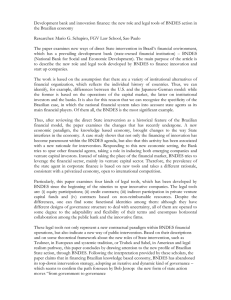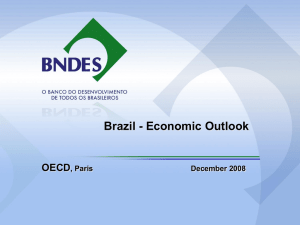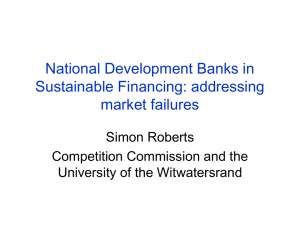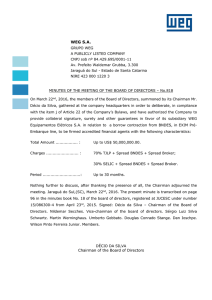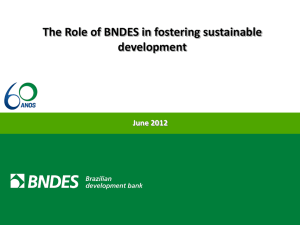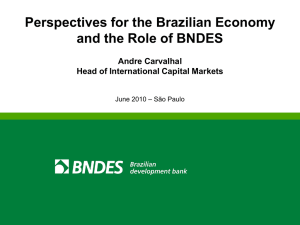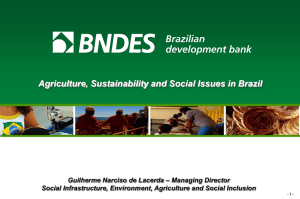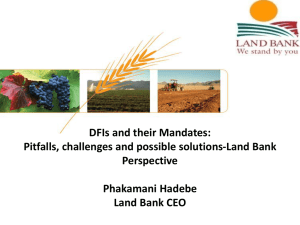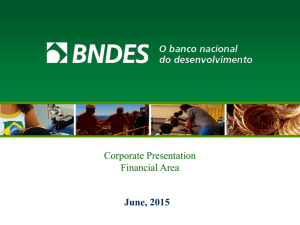Managing State Assets in Brazil: The Case of the National Development Bank
advertisement
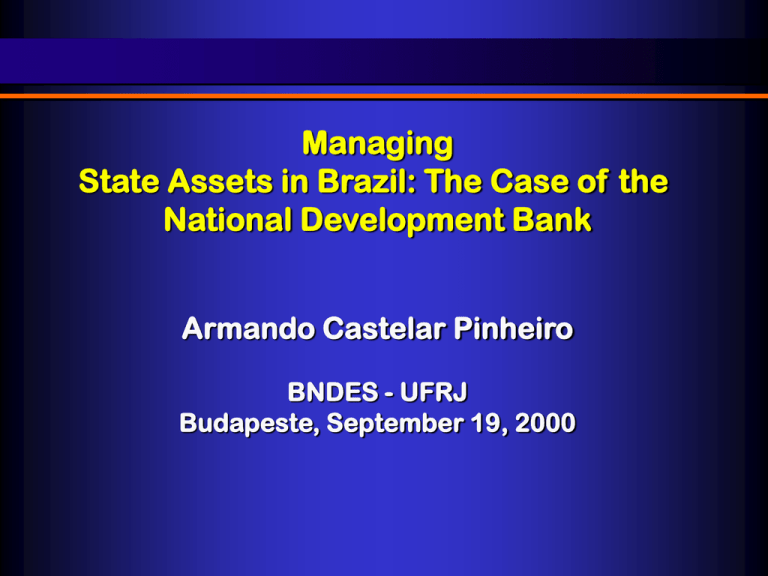
Managing State Assets in Brazil: The Case of the National Development Bank Armando Castelar Pinheiro BNDES - UFRJ Budapeste, September 19, 2000 The Creation of SOEs in Brazil Industrialization drive National security Nationalization of foreign assets (utilities) Verticalization and diversification of SOEs Bankrupt private companies Controlling SOEs in Brazil 1960s: Creation of holding companies (steel, telecom, electricity, etc.) 1967-78: Administrative reform reduced controls over SOEs while keeping privileges 1979-89: Creating centralized expenditure controls and legal restrictions on SOE creation (census) + sale of small formely private SOEs + performance contracts 1990-98: Privatization of large traditional SOEs 1999-: Change in corporate governance Total Results (1991-2000) US$ million Sector Number of Companies Steel Proceeds Debts Transferred Total 8 5,562 2,626 8,188 27 2,699 1,003 3,702 Railroads 7 1,697 - 1,697 Mining 2 3,305 3,559 6,864 26 26,978 2,125 29,103 Power 3 3,909 1,670 5,579 Others 18 1,472 343 1,815 - 1,102 - 1,102 Federal-level 91 46,724 11,326 58,050 State-level 34 26,172 6,592 32,764 125 72,896 17,918 90,814 Petrochemicals Telecom Minority shareholdings Total On February 18, 2000 PND institutional structure Support Ministers responsible for the companies Monetary Council Brazilian Central Bank Inspection, control and follow-up Decision President of the Republic Federal Audit Court House of Representatives Privatization Subcommittee External auditors Privatization Council Management BNDES Evaluation External consultants PND privatization process Inclusion in PND Tenders for consulting Consultant A Financial and economic valuation Consultant B Financial and economic valuation, special auditing, assets and legal appraisal Sale model & financial adjustments Minimum price Call for tenders Auction / Offers Privatization Council - CND Remaining State Assets in Brazil Power generation (being privatized) Real estate (being privatized) Roads (to be partly privatized) Water and sanitation (to be partly privatized) Banks (to be partly privatized) Oil company (not to be privatized, but end of monopoly and sale of shares) Banks: ongoing discussion on what to do Federal 2 commercial banks (agriculture and housing) largest commercial banks in Brazil 2 regional development banks (also commercial) 1 investment bank (BNDES) Local states Several commercial banks being privatized Investment banks turned into development agencies BNDES The Brazilian Development Bank Founded in 1952 100% owned by the Federal Government The main source of medium and long-term financing in the Brazilian economy Main Brazilian partner of multilateral credit organizations 1,600 employees BNDES along the years 50 Infrastructure - Steel 60 Energy - Intermediate inputs - Consumer goods 70 Import substitution of intermediate and capital goods 80 Private industry and agribusiness 90 Private infrastructure and exports Management of privatization process 2 BNDES total disbursements US$ billion 16,5 9,6 1995 16,5 11,8 1996 11,1 1997 2.000 forecast : US$ 13.3 billion 1998 1999 Private sector share (%) Loan Portfolio Disbursements 73% 90% 96% 1998 1999 59% 1997 1998 74% 1999 78% 1997 BNDES group structure BNDES Finances long-term investment BNDESPAR Equity participation FINAME Finances capital goods purchases and foreign trade BNDESPAR • The investment corporation of BNDES • Created in 1982 • Fully-owned by BNDES • A public company since January 1998 • The most important venture capital agency in Brazil Operations cycle BNDESPAR recycling Investment Monitoring Divestment funding interest and dividends BNDES pay debt Investment highlights • Always minority stakes of temporary nature • Valuation is based on each firm’s prospective performance • Investment may also be made indirectly, through one of its closed-end funds • BNDESPAR offers special programs for small and medium-sized technology-based businesses and emerging companies Divestment • Primarily through public offers in the domestic or international capital markets • BNDESPAR often creates new financial products, coupled with derivatives, to promote liquidity and develop the capital market Key BNDESPAR Figures US$ billion Dec-98 Total Assets Dec-99 Jun-00 12.8 11.6 11.6 Net Worth 7.7 5.4 5.6 Market Value 6.9 11.2 10.4 Stocks, funds & bonuses 4.6 9.1 8.3 Convertibles 2.3 2.1 2.0 Investment 3.7 3.2 .3 Divestment 3.9 .6 2.2 Number of Companies 214 197 191 Net Profit (US$ million) 510 366 246 BNDES access to credit Up to R$ 7 million ( around US$ 4 million ) BNDES Automatic - financing through a network of accredited financial institutions (pass-through lending ) In excess of R$ 7 million FINEM - Direct financing Unlimited FINAME - Machinery and equipment (pass-through lending ) BNDES credit policy & procedures Exposure limits: sectors and clients Rating policy and Credit Committee No foreign capital discrimination All loans require collateral and repayment capacity Onlending through financial intermediaries, which assume the final credit risk Changes in SOE Corporate Governance Failure of performance contracts More active board members (outsiders) Minister as president of board More transparent accounting practices BNDES on board of directors of privatized companies with left overs in state hands BNDES - The Brazilian Development Bank www.bndes.gov.br e-mail: financia@bndes.gov.br
